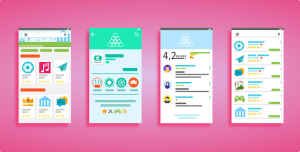Category: UI/UX Design
UI/UX Design: Shaping Digital Experiences and Driving Global Innovation
Introduction
In the digital age, user experience (UX) and user interface (UI) design have emerged as pivotal forces in shaping how people interact with technology. UI/UX design, a holistic approach that combines aesthetics, usability, and functionality, is the art of crafting intuitive and engaging digital interfaces. This article delves into the intricate world of UI/UX design, exploring its multifaceted aspects, global impact, economic significance, technological evolution, regulatory landscape, and future prospects. By the end, readers will gain a comprehensive understanding of this dynamic field and its role in transforming industries worldwide.
Understanding UI/UX Design: Definition and Core Components
Definition: UI/UX design encompasses the process of designing digital products, such as websites, mobile applications, and software, with a user-centric approach. It involves creating interfaces that are not only visually appealing but also easy to use, efficient, and enjoyable.
Core Components:
-
User Research: Understanding user needs, behaviors, and preferences through interviews, surveys, usability testing, and analytics is fundamental to UX design.
-
Information Architecture (IA): Organizing and structuring content in a logical manner ensures users can easily navigate digital products. IA involves sitemaps, wireframing, and creating clear hierarchies.
-
Interaction Design: This focuses on how users interact with the interface, including designing user flows, defining interactions, and implementing feedback mechanisms to enhance usability.
-
Visual Design: The aesthetic aspect of UI design involves color schemes, typography, imagery, and layout to create visually appealing interfaces that align with brand identity and user preferences.
-
Usability Testing: Iterative testing ensures the designed product meets user expectations and performs well in real-world scenarios, leading to improvements based on user feedback.
Historical Context: The roots of UI/UX design can be traced back to the early days of computing, with pioneers like Douglas Engelbart and his NLS system (oN-Line System) in the 1960s introducing fundamental concepts of interactive computing. Over time, with advancements in technology and increasing user demands, UX design evolved from a niche field to a critical aspect of product development. The rise of mobile devices further emphasized the need for intuitive and accessible interfaces, propelling UI/UX into the mainstream.
Global Impact and Trends: A Cultural and Regional Perspective
UI/UX design’s influence is felt worldwide, shaping digital experiences across diverse industries. Key trends and regional variations highlight its global impact:
-
North America: Known for its tech hubs like Silicon Valley, North America is at the forefront of UI/UX innovation. Companies like Apple and Google have set industry standards with their user-centric design philosophies. The region’s strong emphasis on data-driven design and user research has led to sophisticated UX practices.
-
Europe: With a rich cultural diversity, Europe offers a unique perspective on UI/UX. Countries like Sweden (Spotify) and Finland (Nokias’ return to form with HMD Global) have contributed innovative designs centered around simplicity and functionality. European regulations, such as GDPR, also influence design practices regarding user privacy and data protection.
-
Asia: Rapidly growing tech markets in Asia, particularly China and Japan, are witnessing significant UI/UX advancements. Asian companies like Alibaba and Tencent have developed sophisticated e-commerce and social media platforms with intuitive designs tailored to local preferences. The emphasis on mobile-first design reflects the high penetration of smartphones in these regions.
-
Emerging Markets: Countries in Latin America, Africa, and Southeast Asia are witnessing a boom in UI/UX design as digital adoption increases. Local startups are leveraging design thinking to create unique solutions addressing regional challenges, fostering innovation with global appeal.
Trends Shaping the Future:
-
Voice User Interfaces (VUIs): With the rise of smart speakers and voice assistants, VUIs are gaining traction. Designing for voice interactions requires a different approach, focusing on natural language processing and conversational design.
-
Artificial Intelligence (AI) in Design: AI tools are transforming UX by automating tasks like user research, personalizing interfaces, and predicting user behavior. These technologies enhance efficiency but also raise ethical considerations regarding data privacy.
-
Micro-interactions: These subtle animations and visual feedbacks improve the overall user experience, making interactions more engaging and intuitive.
-
Design for Sustainability: Environmental consciousness is influencing UI/UX, with designers focusing on creating eco-friendly digital products and reducing e-waste.
Economic Considerations: Market Dynamics and Investment
The UI/UX design industry is a significant contributor to global economic systems, driving innovation, job creation, and investment.
-
Market Size: According to a report by Grand View Research, the global UX design market size was valued at USD 57.1 billion in 2021 and is expected to grow at a CAGR of 18.4% from 2022 to 2030. This growth indicates the increasing demand for high-quality user experiences.
-
Investment Patterns: Top tech companies invest heavily in UI/UX design, recognizing its impact on user engagement and conversion rates. For instance, a study by Usability.gov revealed that improving website usability can increase conversions by up to 400%. Startups and established enterprises alike are allocating substantial resources to build strong design teams and hire top talent.
-
Economic Impact: Effective UI/UX design contributes to business success by enhancing customer satisfaction, increasing user retention, and driving revenue growth. It also facilitates digital transformation, enabling companies to stay competitive in an increasingly digitalized world.
Technological Advancements: Powering the Future of Design
Technological innovations are at the heart of UI/UX evolution, pushing the boundaries of what’s possible. Key advancements include:
| Technology | Impact | Potential |
|---|---|---|
| Augmented Reality (AR) and Virtual Reality (VR) | Immersive experiences for e-commerce, gaming, and training simulations. | Could revolutionize retail and education, offering lifelike interactions in digital spaces. |
| Machine Learning (ML) | Personalized recommendations, predictive analytics, and automated user testing. | Enhances usability by anticipating user needs and preferences, leading to more intuitive interfaces. |
| Internet of Things (IoT) Design | Creating seamless interactions between physical devices and digital interfaces. | Enables smart homes, cities, and industries, improving efficiency and convenience. |
| 3D User Interfaces | Offers spatial interactions for 3D modeling, gaming, and design applications. | Enhances immersion and creativity in various fields, from architecture to entertainment. |
Usability Testing: Ensuring Quality and Accessibility
Usability testing is a critical phase in UI/UX design, ensuring the product meets user needs and expectations. Common methods include:
-
A/B Testing: Comparing two versions of a design to determine which performs better.
-
User Surveys and Feedback: Gathering direct feedback from users about their experience.
-
Heuristic Evaluations: Experts review interfaces against established usability principles.
-
Accessibility Testing: Ensuring the design is usable by people with disabilities, adhering to guidelines like WCAG (Web Content Accessibility Guidelines).
Conclusion: Shaping the Digital Landscape
UI/UX design is a powerful force shaping the digital landscape, from mobile apps and websites to smart devices and immersive technologies. Its global impact, driven by technological advancements and cultural variations, ensures that user experiences are intuitive, engaging, and accessible. As technology continues to evolve, UI/UX designers will play a pivotal role in creating innovative solutions that enhance human interaction with digital systems.
UI/UX Design Services: Crafting Seamless User Experiences

UI/UX design services are vital for creating visually appealing, highly functional digital products…….
Mastering Affordable UI Design: Cost-Effective Solutions for Modern Experiences
Elevate User Experiences: Custom UI/UX Design Solutions Unveiled

Custom UI/UX design solutions empower businesses by creating unique digital experiences tailored to…….
Mastering Responsive UI Design: Modern Principles and Future Trends
Modern UI/UX Design: Principles, Tools, and Trends for Effective User Experiences

Modern UI/UX design has evolved significantly, prioritizing user-centric experiences, simplicity, an…….
Revolutionize UI Design: User-Centered Approach for Optimal Interfaces

User-Centered Design (UCD) in UI design places user needs at the forefront, aiming for excellent usa…….
Mastering UI/UX Design: From Research to Modern Trends
Unleash Potential: Custom UI/UX Design Solutions for Seamless User Experiences

Custom UI/UX design solutions transform digital products by creating unique, tailored experiences th…….
UI Design Mastery: User-Centric Approaches & Future Trends

User-Centered Design (UCD) revolutionizes digital product creation by placing users at the core of e…….



